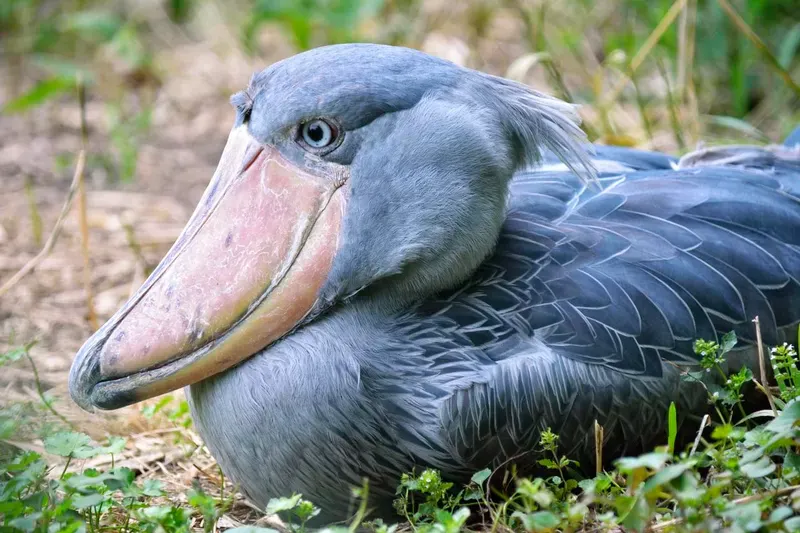Facts About Shoebill

The shoebill stork (Balaeniceps rex) is one of the most bizarre and fascinating birds on the planet. With its enormous, shoe-shaped bill, piercing stare, and slow, statuesque movements, the shoebill has captured the imagination of bird lovers, biologists, and nature enthusiasts worldwide. Native to the swamps of central tropical Africa, this rare bird stands out not just for its appearance but also for its behavior and biology. Here’s a deep dive into everything you need to know about the incredible shoebill.
1. Unique Appearance and Size
The shoebill is named for its massive, bulbous bill, which looks like an old-fashioned wooden shoe. This beak can be 7.4 to 9.4 inches (19–24 cm) long and is lined with sharp edges and a powerful hook at the end for grabbing and tearing prey.
- Height: About 3.5 to 5 feet (1.1 to 1.5 meters) tall
- Wingspan: Up to 8 feet (2.4 meters)
- Weight: 10 to 15 pounds (4.5 to 7 kg)
Its bluish-grey plumage, stork-like legs, and solemn gaze give it an almost prehistoric, dinosaur-like look, often compared to a creature from the Mesozoic era.
2. Not Actually a Stork
Despite its common name, the shoebill is not a true stork. DNA studies show that it is more closely related to pelicans and herons, forming its own taxonomic family—Balaenicipitidae. It’s a unique evolutionary relic with no close relatives.
3. Silent Hunters with a Violent Feeding Strategy
Shoebills are patient and deadly ambush predators. They hunt in swamps, standing perfectly still for long periods and then striking with lightning speed. Their main prey includes:
- Lungfish
- Eels
- Catfish
- Frogs
- Baby crocodiles
- Snakes
They use their bill to clamp, crush, and decapitate prey, sometimes engaging in a violent “head shake” to kill before swallowing whole.

4. Strange and Rare Vocalizations
Although often silent, shoebills do make sounds. One of their most distinctive noises is a bill-clattering display, used in greetings or while nesting. They also emit moo-like grunts and high-pitched whines, especially when interacting with their chicks.
5. Parenting Style and Nesting Behavior
Shoebills nest in floating vegetation or on raised platforms in swamps. A pair will usually lay two eggs, but typically, only one chick survives. The stronger chick outcompetes the other or pushes it from the nest in a natural survival mechanism called obligate siblicide.
Both parents feed the chick by regurgitating partially digested food. Shoebill parenting involves shading the chick from sun and bringing water in their beaks to cool the young bird.
6. Solitary and Territorial
Shoebills are extremely solitary, only coming together to breed. They defend large territories and are known for their slow, deliberate movements. This stealthy behavior helps them approach prey undetected.
7. Conservation Status and Threats
The shoebill is currently listed as Vulnerable by the IUCN, with an estimated population of only 3,000 to 5,000 individuals. Their main threats include:
- Habitat destruction (due to agriculture, oil exploration, and development)
- Capture for the exotic pet trade (they are highly sought after and illegally trafficked)
- Disturbance from eco-tourism and humans
- Climate change impacting wetlands
8. Shoebill in Popular Culture and Lore
The shoebill’s odd appearance and intense gaze have made it a viral sensation online, where videos of its “death stare” and bowing behavior have earned millions of views. In Japanese culture, it’s sometimes called “shūbiru”, and is beloved for its calm yet creepy demeanor.

Conclusion
The shoebill is one of the world’s most distinctive birds—an evolutionary marvel that evokes awe and curiosity. With its bizarre bill, powerful hunting skills, and prehistoric looks, it stands out as a symbol of the untamed mystery of Africa’s wetlands. Protecting its fragile habitat is essential to ensure this living dinosaur doesn’t go extinct in our lifetime.



